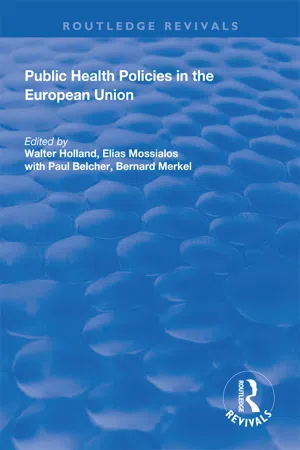History
Public Health in UK
Public health in the UK has evolved over centuries, with key milestones including the establishment of the National Health Service (NHS) in 1948 and the implementation of various public health acts. The focus has shifted from infectious diseases to addressing lifestyle-related health issues and health inequalities. Public health efforts in the UK continue to prioritize disease prevention, health promotion, and improving population health outcomes.
Written by Perlego with AI-assistance
Related key terms
5 Key excerpts on "Public Health in UK"
- eBook - ePub
Prevention
Toward a Multidisciplinary Approach
- Robert E Hess(Author)
- 2014(Publication Date)
- Routledge(Publisher)
In this chapter we will provide a brief description of the evolution of the community prevention movement in public health, including major theoretical assumptions and methods of inquiry. The rest of the chapter will be devoted to illustrations of two major community health problems, approaches used to address them, and descriptions of the solutions to these problems that have been achieved, or are being achieved, through the public health movement. We have chosen to address health problems that have threatened special segments of the population, and in each case we have explored the social meanings of the population subgroup in question. First, we will discuss issues of infant mortality and child health in the late nineteenth and early twentieth century. Then we will turn to a more current problem, that of today's epidemic of acquired immune deficiency syndrome (AIDS), which has affected disproportionately the gay population. In each case, we will describe the health problems in question and characterize their effects on both individuals and the community at large. We will describe efforts to solve these problems and the health care context within which these efforts have taken place. Finally, we will attempt to show that public health efforts focused on each of these problems — although separated in time by nearly a century — have played a similarly critical role in forging a proper balance among competing economic, social, and humanitarian concerns, as well as in improving the health of individuals.Public Health as Community Prevention: An Historical Perspective
It is difficult to pinpoint exactly when public health became recognizable as a distinct profession or discipline, although efforts to control disease within communities — primarily through sanitation efforts — are clearly recognizable in historical records of the public planning, engineering, and health and safety regulations of the Roman Empire. Even some 3,000 years earlier, the Minoans, and later the Mycenean and Egyptian societies, constructed public drainage systems. The Romans probably elevated public health to the highest levels prior to colonial times, however, as evidenced by their public bath houses, elaborate water and sewer systems, and the development of hospitals, as well as procedures for cremation of the dead, ventilation of houses, masks for protection from occupational hazards, and other hygienic advances. Their achievements clearly reflected an awareness of environmental hazards and social factors in disease, as well as a high level of social responsibility. Public hygiene practices declined in many respects during the Dark Ages, however, when this period was witness to recurring pandemics of bubonic plague that eventually killed one-fourth of the European population. The first quarantine laws were developed during this era, suggesting some knowledge of the communicability of diseases, but the greatest health efforts were those expended in caring for the ill. By the sixteenth century, the prevalent theory guiding public health efforts was based on a belief that it was foul air, or "miasmas," that caused disease. Interest in public health practices began to revive. Rules and regulations regarding public water and sewage, and the quarantining of households where there was illness were methods aimed at controlling the odors associated with corrupt air. Although it provided little comfort to a world where contagious diseases yielded a life expectancy of less than 35 years, the theory of "miasma" did not die easily (Burton & Smith, 1970; Rosen, 1958). - eBook - ePub
- Walter Holland, Elias Mossialos, Bernard Merkel(Authors)
- 2018(Publication Date)
- Routledge(Publisher)
Setting Public Health Priorities in the UKMichael O’BrienIntroduction
This chapter uses the definition applied to public health by the report of the Committee of Inquiry into the future development of the Public Health function in England in 1988.1 The report wrote of, ‘the science and art of preventing disease, prolonging life and promoting health through organised efforts of society’. In 1957 a joint committee of the International Labour Office and the World Health Organisation crystallised a description of industrial health which can be paraphrased to develop the above definition of public health. Using this description as a basis it is suggested that Public Health should aim at:- the promotion and maintenance of the highest degree of physical, mental and social functioning for all;
- the prevention among populations of departures from health caused by their circumstances;
- the protection of populations from risks resulting from factors in their environments adverse to health;
- the maintenance of populations in circumstances adapted to their physiological and psychological abilities;
- the restoration to health, where possible, and the maintenance of residual function in others, when there is ill health; and to summarise
- the adaptation of life to people and people to their lives.
This is a sophisticated expansion of the traditional triad of needs to protect the health of the public, namely security from disease, starvation and violence. It reflects the complexity of life in Europe at the end of the twentieth century.Background
Social and economic changes in the British Isles prior to the eighteenth century created a situation ripe for industrial development. New sources of power, mechanisation and new methods of transport all combined to provide new health problems for the population. The effects of the new industrial life gradually led to organised attempts at easing the burden. Writing later about industrial conditions in the nineteenth century Hunter2 - eBook - ePub
Healthcare as a Universal Human Right
Sustainability in Global Health
- Rui Nunes(Author)
- 2022(Publication Date)
- Routledge(Publisher)
8 Public Health as a Social ChoiceDOI: 10.4324/9781003241065-9The state of a population’s health is deeply influenced by economic, social, political, and therefore, cultural factors. That is, social factors create and shape the patterns of health and disease. This principle of social epidemiology necessitates the adoption of clear public health measures, particularly in education, basic sanitation, infectious disease control, and social protection mechanisms, among others. If concerted, these effectors can have a decisive, positive impact on the quality of life, disease prevention, and life expectancy; that is, overall gains in health.The principles underlying public health, which is the science and art of organizing communitarian health efforts, are in apparent contradiction with all forms of biological determinism, particularly genetic determinism. This has caused some tension between social epidemiology and techno sciences. This perspective seeks to improve the population’s health conditions in a communitarian context. However, intuitively, the real patient always takes precedence over the statistical patient once the former is the ultimate object of public health and epidemiology than the latter, which is its operational instrument. Moreover, when we ethically reflect on the paradox of prevention, we can recognize that health policy and public health measures may or not bring substantial benefits to the individual patient. Some authors even advocate for the existence of a new ethic for public health, namely the importance of health promotion at crosscutting level throughout society as an ethical imperative of the health professions (Beauchamp and Steinbock 1999 ).On a global scale, it is recognized today that globalization is not only an economic or cultural endeavour, but it is also an evolution of huge civilizational impact (Engebretsen and Heggen 2015 - eBook - ePub
The Evolution of the British Welfare State
A History of Social Policy since the Industrial Revolution
- Derek Fraser(Author)
- 2017(Publication Date)
- Bloomsbury Academic(Publisher)
© Derek Fraser 2017 Derek Fraser The Evolution of the British Welfare State https://doi.org/10.1057/978-1-137-60589-4_4Begin AbstractEnd Abstract4. Public health
SummaryThe rapid growth in population and its concentration in industrial cities lacking the basic infrastructure of water supply and sewerage created new public health problems. Medical science had not yet discovered the germ theory of disease, but Edwin Chadwick was able to demonstrate in his famous 1842 Sanitary Report that there was a causal relationship between the urban environment and life expectancy. He advocated new legislation and the water-borne disposal of sewage and was partially successful in the passing of the 1848 Public Health Act. Public health reform raised important ideological issues about the rights of property, centralisation and local self-government. In the mid-Victorian years much progress was made in public health administration, mainly at the local level, under the leadership of Simon, effectively the first national Medical Officer of Health. By the end of the century there was comprehensive legislation and local public health institutions, and the death rate fell. Historians debate the role of public health in increasing life expectancy, as against rising wages and improving diet and living standards.4.1 I The nature of the problem
In many ways, despite periodic visitations of bubonic plague, there was no real public health problem in pre-industrial England. London and the centres of some of the provincial market or cathedral towns contained cramped houses, but the vast majority of the population were spread thinly over the rural areas. It was the Industrial Revolution, accompanied by a massive shift in population from rural to urban areas, which created a public health problem. As with so many other social questions, it was the very concentration of people which caused the difficulty. It was only in the so-called age of great cities that society needed that essential combination of preventive medicine, civil engineering and community administrative and legal resources known by the generic term ‘public health’. - Tony Moore, Raj Lakha(Authors)
- 2007(Publication Date)
- Routledge(Publisher)
7
Historical Context of Environmental Health and Communicable Disease Control within the UK
In this chapter:• Introduction.• Concise history of infectious disease in the UK.• Food Safety.• Present day management and control of infectious disease.• Case study: Mary Mallon (Typhoid Mary) – a healthy carrier.• Legal and practical control of food poisoning.• Food hazard warnings.• Legislative control of food borne communicable disease.• Control of public health pests.• Legislative control of food safety.• Severe Acute Respiratory Syndrome (SARS).• Avain Influenza.7.1 Introduction
The roots of environmental health are fragmented in nature, whose origin can be traced to the late eighteenth century. The Industrial Revolution resulted in major shifts in populations from rural to industrial environments predominately in the larger towns and cities. This resulted in rapid expansion in the size and population of industrial towns. The need to house the industrial inhabitants was great, placing enormous pressure on the existing industrial housing stock. The problems of housing people and providing them with adequate food, water and facilities to remove sewage allowed several killer diseases to spread with terrifying ease. The need to relocate industrial workers close to their workplace had two major effects in relation to human health. The first was the proliferation of high-density housing. Multi-family occupancy of single rooms were not uncommon, such dwellings often lacked basic amenities such as wholesome water supply and water closets. The second was the general absence of effective planning laws, which allowed the placing of domestic properties in the close proximity of the polluting factories.7.2 Metropolitan life
Public utilities struggled to maintain adequate water supply and drainage systems for the expanding towns. Excessive demand in relation to the inadequate supply led to generalised water shortages. The transmission of waterborne communicable diseases was facilitated by these conditions. The inadequacy of municipal drainage systems encouraged the depositing of polluting matter from industrial and domestic effluent into watercourses, which were used to transport the effluent to the sea. It has been argued that the development of sewers were neither inevitable nor even the best possible solution to the problem of waste disposal. The first paradigm of sewage being merely inconvenient ‘run off’ and sewers being open streams had to be redefined as ‘dangerous pollution’ and ‘underground waste disposal pipes’ respectively. The growing early community of civil engineers needed to change existing environmental and cultural perceptions with technical ones. Sewage became a hazardous by-product of metropolitan life, which engineers had designed a system of pipes, reproducing and relocating polluted streams that had once constituted the natural drainage systems (see Porter D H The Thames Embankment Environment, Technology and Society in Victorian London
Learn about this page
Index pages curate the most relevant extracts from our library of academic textbooks. They’ve been created using an in-house natural language model (NLM), each adding context and meaning to key research topics.




